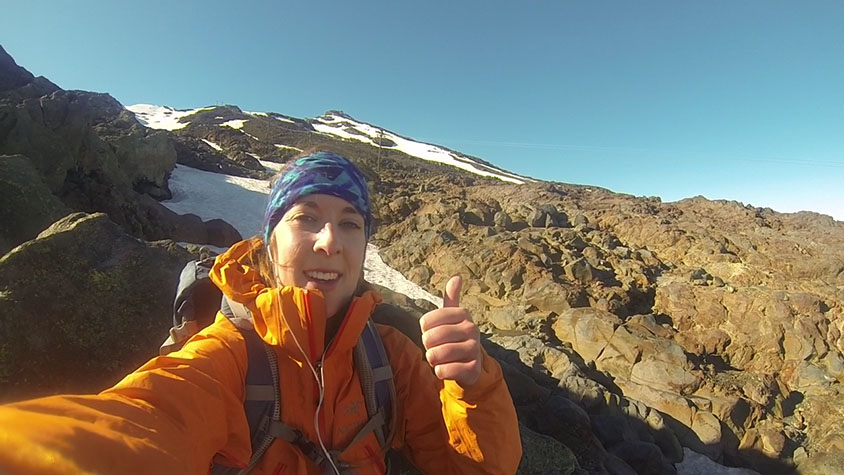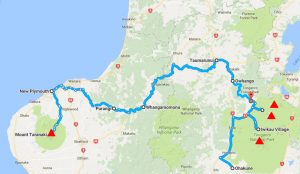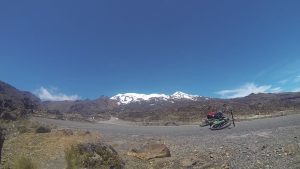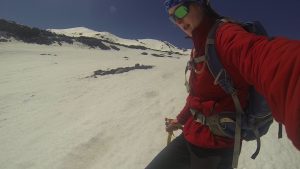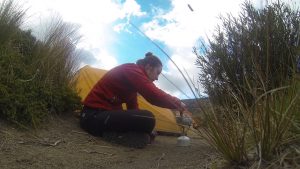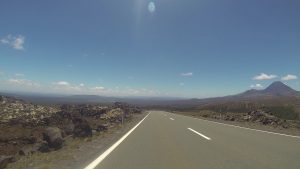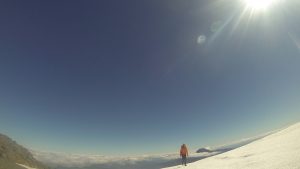By Emma Kent
Alicia Anson wasn’t brought up as an adventurer.
Alicia and her family went camping regularly, but she wanted something more from her love of the outdoors. A desire that wasn’t shared by her family. At some point, Alicia decided that she was prepared to suffer to experience everything there is to offer in the big wide world, away from the city lights and crowded suburbs.
Inspired by professional rock climbers Cedar Wright and Alex Honnold, Alicia decided in January 2017 to embark on her own version of a ‘sufferfest’.
The definition of a sufferfest is an activity where all participants ache, agonise, ail, be at a disadvantage, be racked, deterioriate, endure, grieve, languish, and/or writhe… but by co-misery and cohesiveness they experience a grand time. Often survived only through sarcasm.
Sound fun? Alicia thought so, except she wanted to do the whole thing solo.
Planning for pain
Alicia set out to climb four volcanoes in New Zealand’s North Island travelling between each by bike. She planned to go unsupported and alone for the entirety of the 11-day tour.
To top it off, whether by poor planning or sheer determination, Alicia did not factor in one single rest day on her quest to complete her personal sufferfest.
Mount Taranaki on the New Zealand coast would be the focal point of Alicia’s trip; the aim at the end would be to stand on top of this 2,518-metre peak.
She then found three other volcanoes that marked out a rough circuit, allowing her to cycle easily between each one. Thus, Alicia’s Volcanic sufferfest was born.
“I had become obsessed with the idea and when I explained it out loud to someone, I thought ‘Well, this is happening!’,” Alicia explained.
Day 1: Bundling into Iwikau Ski Village, Ruapehu
Flying into Wellington, New Zealand, Alicia found herself a bike and caught the train north to a town called National Park.
Alicia was the sole traveller getting off at the National Park stop; the level of isolation would soon become emblematic for the journey overall, but for now her only thought was the day’s destination: Ruapehu.
The ride to Mount Ruapehu took Alicia an afternoon of cycling – all uphill, and with 11 days worth of food and supplies in baggage.
“It was a horrible start to the experience,” she later said, revealing the true sufferfest spirit.
Following a road less travelled, Alicia had to walk her bike most of the way up to what would have been a ski village called Iwikau in winter, but was currently just an empty set of cabins on the side of a mountain. So, she spent the night in an emergency shelter in Iwikau before planning to head up the rest of the mountain on foot in the morning.
Day 2: First peak
When Alicia woke to a lot of rain, she remembered she didn’t have any contingencies, so up the mountain she went in her wet weather gear.
“There were no tracks. I just Googled whether you could climb it, not whether people did climb it,” she said.
The rocky, scree-covered terrain is what Alicia describes as “classic volcano terrain” and makes for a fairly easy volcano to summit, even with significant snow on top. Thus, Alicia climbed Ruapehu (as she would her other volcanoes) without rope or harness, carrying an ice hammer as the only gear that might prevent a fall.
“It was the best. I was all by myself,” she said. “It was classic mountaineering, with no noise, just the sound of the wind.”
It’s worth noting at this stage that climbing mountains in a foreign country, with minimal gear and, especially, on your own, is not recommended as ‘safe practice’. However, when Alicia reached the top of Ruapehu in a relatively short time and with relative ease, she felt confident that the trip would come off without too much trouble.
The next adventure
Arriving back at her Iwikau base camp, Alicia retrieved her stash of belongings and paused for lunch.
“Lunch was just energy bars, as I didn’t pack a proper lunch,” she tells me. “I just had chocolate and these amazing New Zealand protein energy bars. That was pretty much all I ate for four days.”
After her square meal, Alicia clambered back on her bike and went down the hill that she’d slogged up the entire afternoon of the day before, making it down in an impressive 10 minutes. When she got to the base of Mount Ruapehu, instead of turning to go back to the comfort and safety of National Park, she headed in the opposite direction: down the highway in search of her next adventure.
The next adventure began with another uphill stretch on a dirt road. The warm day made this section of road particularly difficult, and making matters worse Alicia had to continue to dodge flying bits of gravel flicked up into the air by passing cars.
Eventually, she made her way to the head of a walking track, where she endeavoured to find a safe hiding spot for her bike and a few of her belongings. From there, she completed the 40-minute walk to Mangatepopo Hut on the famous Tongariro Northern Circuit, where she would rest for the evening.
After a long day climbing and cycling, and with New Zealand in the grips of daylight savings, Alicia found it easy to fall asleep before sundown.
Day 3: Ngauruhoe and Tongariro
In order to conserve space and weight, Alicia had only packed the fly of her tent for this adventure. Which was fine when the weather was fine, but that night it became quite windy and the wind brought in the soil. But then it was the morning of Day 3 and Alicia woke to more wind, a lot of rain and some fog covering Mount Ngauruhoe and Mount Tongariro – her intended objectives for the day.
Alicia planned on hiking both Ngauruhoe and Tongariro on the same day, as the route to do so is considered popular eight-hour day walk in the area, called the Tongariro Alpine Walk.
Before setting off, Alicia checked the weather at Mangatepopo Hut, thereby discovering the forecasted 100 kilometre per hour winds that day.
“I didn’t plan this very well,” she recalled, “but I didn’t give myself any rest days, so I figured I had to do it that day.”
Alicia started off early, and despite wearing all her available layers, the wind cut right through her. When she reached a fork in the road where most continue straight, she turned left to climb Mount Ngauruhoe (or Mount Doom as the LOTR fans may know it).
Despite the weather warnings, Alicia passed many trampers on the trail that day as she made her way up the scree-covered slope. As she went higher, the trail markers could barely be seen through the thick fog. After two hours in the freezing cold and the weather only getting worse, thoughts of ‘What if?’ began to creep into Alicia’s mind.
‘What if I’m lost?’
‘What if I fall and no one knows I’m up here?’
Alicia continued walking upwards just to say warm, but the thoughts continued to torment her. Eventually, she decided she needed to turn around.
“This is too dangerous,” she told herself. “The conditions are just so bad.”
Extremely frustrated and conflicted by the decision to turn about, Alicia felt she was abandoning her sufferfest – and it was only the second peak she’d attempted.
Coming to terms with Tongariro
Making it back to the fork in the path where she had previously turned off to climb Ngauruhoe, Alicia this time forged along the road more travelled.
Alicia was a little more confident in completing this section of the track as she had done it once before and knew what she was in for and quickly made it to the lower rim of the crater. All the while an intense tailwind pushed her along at an involuntary jog. She passed many walkers going in the other direction that had turned back due to poor weather, and had conversations with some of them about the road ahead.
Arriving at another fork in the road, Alicia again turned off the path – this time to attempt a summit of Mount Tongariro.
Staying low to the ground to avoid being lifted by the wind, which was now coming from both sides of the mountain, Alicia quickly ran over to the summit, took a photo and began her descent. She went back down into the crater with the wind now pushing against her, making the walk even more difficult than before.
When Alicia passed the turn off again to Mount Ngauruhoe, her eyes glanced back up at it, and her mind wandered as she considered another attempt. But instead she kept walking back to the safety of her tent.
Upon arriving at campsite, the sun came out and the wind died down, making Alicia think she had just dreamt up the hell she had just been through earlier in the day. Back inside her tent, she had more conflicting thoughts run through her head of whether or not it was even worth continuing her sufferfest if she hadn’t completed the climb on Mount Ngauruhoe.
“I climbed on it, I attempted it,” she reasoned to herself. “I made a decision – a good decision, a safe decision – and I am going to keep going. I assessed my ability and the weather and made a smart decision,” Alicia’s thoughts were running wild in her mind, but ultimately she chose to continue her adventure.
Next phase: The 42 Traverse
After a short rest at the campsite, Alicia packed up her things and her bike and headed back out to the main road at about 4pm.
“I just felt so crappy the whole time [about the missed summit] and after the first day of riding my legs felt like they had lead in them,” said Alicia.
An hour down the road, with less pep than how she’d started out after summiting Mount Ruapehu, Alicia turned off the main road again onto a dirt road to commence the next phase: the 42 Traverse mountain bike track (although by her count, Alicia has it at 46 kilometres). At 5pm with a lot of daylight left, Alicia decided to start the track and put some of those kilometres behind her done.
Alicia set off on the route without a map – only a few mental notes in her head of how many huge hills she had to get through along the way.
After what felt like a reasonable distance for the day, Alicia set up her tent in a clearing, had a wash and lathered herself in some much-needed Deep Heat before settling in for the night. To help improve her morale, she opted for a tuna meal for the first night after having lived off pasta and tomato sauce the last few nights, and, on what was fast becoming a pattern, it proceeded to rain and bluster all night. She eventually awoke to find herself sleeping in a fresh pile of dirt.
And that’s how Alicia’s fourth day would begin: damp and dirty, the dawn sun hidden behind rainclouds.
Day 4: Torturous traverse
Alicia really didn’t want to get up and ride in the rain… again. But in true Sufferfest style she got up, packed her tent, put all her wet weather gear on and hit the trail.
A recent convoy of quad bikes that had gone through the 42 Traverse left big, muddy tyre tracks that Alicia’s bike kept getting caught up in.
“I didn’t plan for this, I thought January would be dry,” she said.
The mud made the trip much slower and, to make matters worse, plants that grew over the track kept hitting Alicia’s face, no matter how hard she tried to avoid it.
“It was like someone wiping their wet hair all over you, it was disgusting and I was getting madder and madder.”
The 42 Traverse was literally slapping Alicia in the face.
Alicia’s bike slid out from underneath her relentlessly due to the heavy weight on the back and the amount of maneuvering she had to do to dodge the tyre tracks and plants. It was at this point Alicia decided that it was time to put her only item of pure luxury to use: her iPod.
“Music helped, I could get into the beat of it and ride a bit better,” she said.
The sheerness of the hills meant on the down track, Alicia often got off her bike and walked with it. In these circumstances, the weight of the bike was a helping hand. She would let the bike get a little ahead of her and then apply the brakes, walk to catch up with it, then repeat the process until she was safely down.
At the base of these slopes, Alicia had to occasionally navigate creek crossings at that, unlike ones encountered back home in Australia, were four metres wide and fast-flowing. She quickly gave up trying to stay dry while being so wet, so she decided to cross one creek without taking her shoes off. What she didn’t know then was that on the other side was a short steep hill full of clay, with a big old rock right in the middle of the track.
Alicia managed to easily push her front wheel over the rock, but with all the weight on the back she took what felt like ten minutes in a long-winded tug of war between pushing the bike and sliding down the hill, while also trying to prevent the bike from flipping over.
“I got to the top and I was so mad, I started screaming. I was so frustrated with myself and my bike.
“I thought that would have been the worst but it just kept coming, the hills were bigger… I think I just blurred that out of my memory.”
It was the apparent feeling of success in the end that had kept Alicia going. So, she got back on the bike and pushed on, despite not really knowing where she was or how long she had left on the track. Finally, Alicia arrived at her last known checkpoint, which was a crossroads with signs.
At first, she didn’t want to read the signs, fearing they wouldn’t bring good news.
“The signs said I had rode 33 kilometers since the previous afternoon.” Instead of just five kilometres of the traverse left, Alicia had 12. It was just as she’d feared.
The kindness of strangers
After facing another minor setback, Alicia decided she would get to the next town where the track ended at a place called Owhango and treat herself to some nice accommodation she’d found online, which included the promise of a meal and a hot shower.
So, she got back on her bike, put her earphones in and kept going.
With her mind on this new prize at the end, she turned numb, without feeling and just pushed through. Starved of food and direction, Alicia stumbled upon a café in Owhango only to find it had just closed, with no one answering her calls.
Her next move was to locate her resting stop for the night – all she had to do was call the owner on her phone… that had no signal. The pay phone down the road didn’t work either, so Alicia went back to the house to wait. But Alicia isn’t the type to sit still, even after finishing the 42 Traverse, so she started using the facilities, cleaning her gear and hanging it on the line.
“I am a bit embarrassed now,” she said, thinking back. “I would never do that.”
Another family staying in the accommodation, concerned about Alicia’s welfare, offered to call the owner only for him to deliver the devastating news that he was booked out, so she then asked whether she could camp on his lawn – to this he was happy and able to oblige.
The family staying in the house provided the most generous thing Alicia could hope for at the time: allowing her to use their room as her own, including a much-needed shower. They then took Alicia down to the pub for a meal.
Despite feeling a little like a nuisance, Alicia nevertheless relished the opportunity for conversation – something she hadn’t experienced properly for four days.
The owner of the pub charged Alicia a just NZ$10 for the meal and the accommodation after hearing her recount the story for the four days prior.
Then, the kind family offered Alicia a ride into the next town in the morning.
Alicia returned to her tent after saying goodnight to her new friends, and that she’d consider their offer. She was once again torn between pushing through the pain, or yielding. It was only during the night, after being bitten on the head by some kind of slug, that Alicia made up her mind.
“I think the slug decided for me,” she said. “I was done with everything. This is the tipping point.”
A moment of respite
Accepting the ride on to the next town, Alicia was glad for the assistance but soon found herself alone again. She’d just arrived in a town called Taumarunui and she was crying.
Alicia decided she would take an unscheduled rest day to collect herself, as it was the final town before the next epic part of the trip. Her first stop was an Information Kiosk where she stored her bike and, after asking the attendant for details to the wi-fi hotspot, she informed him she that she’d some big decisions to make and would return later in the day.
That’s when Alicia went to a bench and called her mum, knowing that her mum gets worried whenever Alicia’s away on these kind of trips. They’d not spoken since Alicia departed for the sufferfest.
Of course, as soon as she heard her mother’s voice, Alicia broke into fresh tears. Then she told her mum through her tears that she didn’t think she could complete her mission.
“Well, don’t do it,” was the pragmatic response. “Don’t worry, just give up,” she continued as she’d never liked the idea of Alicia taking on the challenge in the first place.
“I don’t want you to tell me to give up, I want you to tell me to do it,” Alicia replied.
“No one cares if you do or don’t do it, only you do,” her mum said.
“But I’ve got to do it,” Alicia said.
She hung up the phone and a moment later her dad rang.
Alicia’s father sensibly told her to do some research and find out what the next section of the trip was like, so Alicia stopped for some food and contacted other people in her life from different areas for different opinions.
Generally, everyone was supportive and proud and told her the same thing as her mother: ‘Only you care if you don’t finish this thing’.
Alicia stayed in the town for the night Taumarunui, and felt like her sufferfest was done.
A skip and a jump to Taranaki
The next planned section of Alicia’s ride was along a bike path called the Forgotten World Highway. It goes through the ‘forgotten world of New Zealand, where nobody really goes to’, I’ve been told, and it is essentially farming land, rolling out to the west coast where Mount Taranaki is.
The road is 180 kilometres long, which would take two to three days to complete with little interaction to the outside world. Alicia knew she would be riding into the unknown, with no camps and no assurance of water. Having reached the lowest point of her trip, Alicia wondered why she’d decided to do the trip and whether it was more about pain or the thrill of adventure. She wasn’t having any fun anymore, so why push on?
This is not what Alicia is hard-wired to do; she did not want to call it quits.
But at her very core, Alicia knew that she would learn more about herself by not continuing and by accepting what she considered as ‘failure.’ She then called back home to give them the news that she had decided to take a bus out to the west coast to her finish line.
Once Alicia had confirmed her place on the bus, she felt as though a huge weight had been lifted off her shoulders. It arrived in New Plymouth at night leaving Alicia to go and find her accommodation.
The next morning, Alicia looked on the weather forecast for the day she would arrive at Mount Taranaki, the only clear day that week was the day she was arriving.
“It was like it was meant to be, I was meant to take the bus,” she said.
Approaching the base of Mount Taranaki was another uphill slog, which made Alicia feel like she was back on Day 1. Approaching the hut, Alicia realised she was going to be alone again. She had no entertainment and her phone and iPod were running low on battery. So, when a young family came up a different track to stay in the hut, she was ecstatic.
Alicia made fast friends with the family, playing cards and telling them stories of her adventures and in the morning, she felt strong and rested ahead of her climb to the top of Mount Taranaki. The walk up the peak was scenic, but otherwise uneventful, leaving Alicia to wonder as the contrast in experience from one day to the next.
Despite the feeling of giving up, Alicia also felt a sense of achievement that she was standing on Mount Taranaki, the volcano that started the whole thing in the first place. From near the summit, she could even make out the peak of Ruapehu – the first peak bagged in her sufferfest.
The return journey
Alicia descended Mount Taranaki with a few other people she met at the top, which was a fitting end to an otherwise lonely adventure. However, the next morning the rain came back for her ride back into New Plymouth.
Despite her troubles, Alicia realised how much she’d achieved by herself and, although her next sufferfest isn’t likely to be suffered alone, she’s in no way put off from attempting another such adventure someday. In fact, if Alicia’s story inspires just one other person to push him or herself on an adventure like this, she would be happy.
Finally, anyone thinking of taking part in any of the walks that Alicia has done is asked to please respect Maori culture and leave nothing put footprints behind. It’s a traditional for the Maori that only Maori people are allowed to stand on the summit of New Zealand’s mountains.
Alicia respected this tradition throughout her adventure, climbing high enough to stand near, but not directly on top of, the summit.


